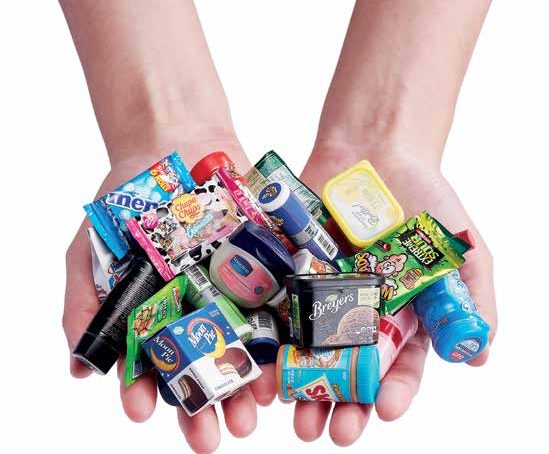Individual single-serving F&B products were very probably first introduced primarily to accommodate the commercial airline industry’s space constraints on aircrafts. The concept was then adopted by hotels over time, leading to global brands using them to serve consumers in povertystricken markets. As people began to spend more time outside of their homes, global and local brands have created their own concepts to cater to an ever-growing audience. HN unpacks this important industry to find out more.


Nabil Gemayel, Chairman and GM ,Gemayel Freres S.A.L.
CHANGING CONSUMER BEHAVIORS AND TECHNOLOGY DISRUPTORS
Sustainability and recycling
Gemayel Frères is a family business, which turns 90 this year. A leading player in Lebanon’s cardboard industry, it is also the oldest, with annual sales of more than USD 25 million and employing 250 people. The company was the first to introduce paper recycling to the area in 1929, a technology which today has become quite popular, if not necessary. Unfortunately, it remains incredibly challenging, despite the fact that we have been at the forefront in finding ways to better serve our clients. In parallel, sustainability is a key element when developing, designing, choosing the right material, manufacturing and recycling any kind of packaging. Whether it is required by consumers who are becoming more eco-conscious or by legislation, sustainability has been, in the last few years, a fundamental aspect in the industry. Though we have been raising awareness about the importance of recycling and the services we offer interested parties, the main problem is in the collection of this waste. Paper-based packaging has an excellent record in this respect as it is heavily recycled (global figures range between 70-80 percent). To better ensure the expenditure of unnecessary energy, we installed a solar power plant under the EU-funded CEDRO project, which was implemented by the UNDP in partnership with the Ministry of Energy and Water. This system allows us to reduce our electricity consumption, therefore significantly reducing the ecological footprint of the packaging produced. Keep in mind that in sectors such as paper recycling, the cost can reach to up to 30 percent of the selling price. Furthermore, the recycling industry in Lebanon is not granted special considerations when it comes to energy costs, which are extremely high compared to neighboring Arab states and Europe, even though we play an important role in the economy.
Lifestyle
Changing lifestyles and consumers’ interests are key factors affecting the packaging industry. For example, the growth of the F&B sector and food delivery services is further driving the on-the-go lifestyle, placing convenience as a main criterion for the packaging industry. Consumers want packaging that makes the product easy to identify when buying, easy to grab, hold, carry, eat and dispose of. Moreover, the food delivery and takeaway sector has pushed the packaging sectors to constantly innovate. This saw the industry developing packaging that conserves the food at an optimal temperature for a longer time period and developing packaging that is easy and practical for transportation.
As a response to this change in lifestyle and purchasing choices, the packaging industry has developed many innovative packaging solutions: designs with friendlier handling to carry the product and consume it; mono portions or easy portioning packaging for practicality and health consciousness; and resealable packaging.
Food waste
Packaging also plays a fundamental role in minimizing product and food waste. With up to 40 percent of the food worldwide being wasted, this is both a challenge and an opportunity for the packaging sector in developing the right designs and materials. The right kind of packaging keeps food and the product fresh for a longer period (extending the shelf life). It also ensures that it is delivered in a safe way by protecting it from damage and external factors, thereby preserving the texture, taste, nutritional value and the required temperature of the product. This also helps decrease waste.

Elie Al Marji, CD, Wondereight
CHANGING CONSUMER BEHAVIORS AND TECHNOLOGY DISRUPTORS
Today, we are seeing major trends that will transform the packaging industry within the next 10 years. Constantly changing consumer behaviors, technology disruptors and sustainability will present major challenges, which will force design and packaging companies to seriously revaluate their strategies. By creating a sense of urgency, investing in R&D and innovation, these trends will present great opportunities for growth, improved profit margins and a shift to how we perceive product packaging.
E-commerce
The move to online retail in general will continue to have a significant impact on packaging needs. E-commerce packaging will diminish the traditional role of primary packaging. As a result, there will be less investment on packaging designed to attract consumers in retail stores and more research in robust packaging that can endure shipping. On the one hand, the challenge for design agencies is to enhance consumers’ unboxing experience. On the other, packaging companies will need to create primary packaging designed for direct shipping without a secondary protective outer box. In turn, this will save the product manufacturer unnecessary expenses and be less harmful to the environment.
Customer-centered packaging
Due to changing consumer preferences, a major game changer arises, namely, personalization. Consumers striving for convenience and more package options, ranging from big-sized to single use packaging, will lead to a huge increase in Stock Keeping Units (SKUs), packaging sizes and forms. This is important when it comes to Lebanese consumers, especially for millennials, who have gotten weary of impersonal experiences offered by international brands. Instead, they are opting for more authentic experiences; shopping at independent stores and avoiding big food companies.
Sustainability
Increased public awareness about the damaging impact plastics have on the environment is putting pressure on governments to push for tougher regulations, especially when it comes to single-use plastic. This, in turn, is constantly challenging big brands to find alternatives that are not only more suitable, but don’t cut into their profit margins or compromise consumer experiences. Because sustainability is also at the heart of the matter, these same companies are starting to use renewable materials to package their products. On the other hand, packaging manufacturers are working on offering brands alternatives resulting in new product designs. One example that comes to mind is canned drinking water instead of plastic bottles.
Price awareness
Cost has always been king in influencing package design and purchase power. Millennials have smaller disposable incomes than their parents and therefore, having the right product at the right price range is paramount. Furthermore, the entire miniaturization trend has become less costly due to digital printing, which helps in cutting down costs and creating limited labels for e-commerce. Lastly, especially today, the emergence of price-sensitive consumers is in part due to their ability of using e-commerce sites to compare the cost of different products in the same category. In other words, companies can no longer manipulate the price of their products as consumers will often take the time to find the best offer in terms of value for their money. Therefore, packaging companies will need to develop creative solutions to reduce costs without compromising features of convenience and sustainability.
Smart and virtual labels
For us, as a design agency, we are currently focused on the integration of traditional packaging with IoT (Internet of Things) solutions in mind to enhance the brand’s narrative and give the consumer a genuine feel of the brand. This is happening through the use of smart labels that can indicate, in realtime, the product’s remaining shelf life, integrity, production source, to data mining (extracting immense insights directly from consumers) to virtual labels. The role of virtual labels (AI and AR enabled packaging) is to support the brand’s storytelling with videos, testimonials and photos of the brand’s source. Design agencies will have a new platform to tell their story using packaging by employing entertaining content relevant to millennials, the mobile generation. Product and process innovation are key. So, design agencies have to step up their game and packaging companies will need to develop a new business model based on the above-mentioned trends to succeed and impact the future of packaging.

Raya Nawbar, CEO, Brandmint
ECO-FRIENDLY, RECYCLABLE AND ORGANIC
Global trends, in most cases, end up affecting regional and local ones. At the moment, the biggest world trends are still focused on the eco-friendly, recyclable and organic factors.
Food safety
As more F&B outlets offer take-away and delivery services, the importance of all elements incorporated into the packaging being ‘food approved’ has become central. Previously, the only materials that required a seal of approval by a country’s governing body were the paper and packaging in which the food came. That is no longer the case because even components such as the ink, lamination and varnish have to pass food safety inspections to ensure no chemical interaction or contamination occurs. This is hardly surprising, given that the F&B sector requires more packaging than any other. Due to this demand, the packaging itself has become simpler, in the sense that fewer brands are using plastic ‘windows’ to showcase the contents of their products, especially when it comes to those in the organic range. On that note, not everyone is aware that because organic foods contain no preservatives, their shelf life is significantly shorter. This in turn means that brands offering such products are limited to how many items they are able to sell on a daily basis, which is problematic. In other words, a brand may be offering consumers healthier options, but as a result, might be selling less.
On the go
The other, equally interesting trend relates to consumers’ changing lifestyles. In response, and due to the fact that people are spending more time outside of the home, giving birth to fewer children and even enjoying solitary pursuits, brands are offering downsized options using more practical ‘on-the-go’ packaging. This solution, though more suitable for many, generates more waste, even if the packaging is recyclable, ecofriendly and uses one layer of packaging instead of two.
This relatively new industry is growing at phenomenal rates due to technological advancements. The key change is that previously, most packaging would be produced using ‘die cutting’ – a time-consuming and quite laborious manufacturing process that is expensive and does not always generate the best results. Today, however, producers are relying more on ‘laser-cutting’ processes previously reserved for industrial manufacturing. This technology not only offers more accurate results, but has also become necessary in today’s F&B industry to ensure the integrity and quality of the products sold.
To that end, we worked with French multinational Fromagerie Bel, which offers Picon, a spreadable cheese, to design a new range. Titled Piconettes, it contains the cream in one compartment and breadsticks in the other. Another brand we worked with is Bartartine’s Bake & Brew, offering consumers a faster, cheaper and more casual eating experience through ready-to-eat goodies. One other example that further illustrates that trend, is the work we did for Castania Boutique by creating on the go healthy bars and small portions of healthy nuts.
Furthermore, we always advise our clients to minimize and simplify their packaging, since, when you have food delivered, the amount of waste that ends up in the garbage can easily occupy more space than the food on the table, which is ridiculous.

Soha Atallah, VP, WPO Founder, LibanPack
TWO GLOBAL TRENDS AFFECTING THE REGION
There are two main global trends today affecting the entire packaging industry, which ironically are largely contradictory. The first, is the heavy emphasis on the ‘snacking’ industry. This sees various F&B brands selling the same products such as chips, juices, dried fruits and nuts to name a few, using downsized packaging intended to be consumed on the go. The trend is also expanding to other industries selling pharmaceuticals and hygiene related products.
The challenges
Accommodating such a trend, runs against the second trend, namely miniaturization. While on the one hand it accommodates the on-the-go lifestyle, on the other, it produces more waste and therefore is counterintuitive. Ironically, that consumer segment is also willing to pay more for less. Another contradiction comes in form of the most dominant local and global trend, which I hold to be illogical. It has consumers calling for the avoidance of using all plastic products when deemed unnecessary. To me, that decision is similar to someone hiding behind his/her finger. The first problem on that front is waste management and lack of waste sorting. In other words, plastic is not the only problem, the main problem is how we, in Lebanon and other countries, are disposing of that plastic waste considering the absence of proper waste sorting systems. Also, people need to understand that they cannot entirely do-away with all plastic-based packaging, since most of these are used to transport and extend the shelf life of food products and are therefore necessary. Our concerns as WPO is on avoiding food waste through proper use of optimal amount and type packaging materials to protect and preserve the products and to design a sustainable packaging from the other perspective by avoiding over packaging. However, as previously mentioned, doing away with plastic is not a viable solution, at least not at the moment from WPO perspective. On the other hand we are in favor for the restrictions on some single use plastic Items and replace them with sustainable solutions.
On the visual design front
Currently, two schools dominate. On the one hand, the ‘less is more’ trend is what consumers in America and Europe are going for. In other words, they prefer minimally and less crowded visually designed packaging to promote these products clearly. They like neat-looking packaging that has a white background, looks simple and reflects the health benefits they seek. As for consumers in Russia, China and the Adriatic region, they still prefer packaging that is cluttered with strong and bright colors, especially if these are shiny and come in silver or gold. This, to a fairly large degree, is also common to Middle Easterners.
However, what I deem striking, is the fact that Lebanese consumers’ preferences sway closer to those of their American and European counterparts. What is interesting, is that these products now look and feel more similar to international brands that belong to the same category. Also, local brands are looking very similar to international ones further proving that consumers are gravitating in that direction.
Connectivity
Another noticeable trend gaining traction in-line with simplicity and minimalism is ‘connected packaging’ containing QR codes. This vehicle allows manufacturers to achieve two key goals, namely minimize the information displayed on the packaging and in turn lower overhead printing costs, as well as ensure that the brand’s consumer base has immediate access to all kinds of product-related information. On a different yet equally important technological front, e-commerce has become a profit-laden vehicle. Though it is not as evolved in Lebanon as much as in other countries, the packaging used by manufacturers to increase sales takes into account the appeal these products have online as opposed to on a brick and mortar store shelf. This necessitated producers to pay special attention to the type of packaging their online products come in, which merit a different kind of consideration.
Yet all considered, what remains Lebanon’s most challenging package-related issue today is proper recycling. Here, it is important to note that all materials are recyclable, but not all materials are being recycled due to the lack of recycling facilities and the lack of waste sorting systems.














